Aug 2008
Pro Photography Now: The Good, The Bad, The Ugly
August/31/2008 Random Thoughts
After spending a week at home without the rigors of traveling that sometimes muddle my brain, I've done some thinking about the state of business among studio photographers. These reflections were prompted by the fact that I'm nearing the end of my teaching schedule this year . . . a year in which I've taught more classes to more students than in any other period of my career. For years you couldn't give away a business class; today there are waiting lists for marketing and management workshops and seminars, and the classrooms are filled to overflowing. This shift should come as no surprise, given the huge numbers of new photographers in the industry, the prevalence of automatic prosumer cameras, and the ongoing challenges of still-evolving digital technology. Nonetheless, I suspect that some of the things I've observed this year might be of interest, given the fairly chaotic nature of our industry today. So here goes:
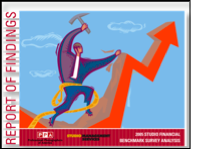
The Bad
The following observations come from interacting with the photographers I’ve seen in class or worked with personally in 2007 and 2008 (they amount to several thousands), as well as to information I have received from a group of well-respected instructors and consultants with whom I regularly converse. I believe these problems are fairly widespread.
The Ugly
When markets are unstable, “The Bad” slips easily into “The Ugly,” resulting in an out-of-control business situation that is very stressful for the photographer as well as disheartening for instructor or consultant who wants to help. No matter how hard the photographer is willing to work, or how well-intentioned the helper is to pull the unstable business back from the brink of disaster, when business weaknesses are so pervasive, their consequences can be impossible to reverse. So here are my top warning signs that constitute The Ugly in today’s industry:
So where do we stand?
In spite of the fact that Bad and Ugly business practices in the studio industry today have created a fairly chaotic environment for photographers and consumers alike, I’m pretty optimistic. I can still remember hearing stories from my early teachers about the chaos created when photographers moved from black-and-white film to color: They had to cope with new lighting systems; they were no longer able to control their images in a black-and-white darkroom; and the first color films were unstable and did not portray color accurately; and finished prints faded very quickly. But when photographers learned to outsource their work to professional color labs, they found they could produce products that thrilled consumers, and once they were out of the darkrooms, they could spend more time with clients and do a better job of marketing and managing. Soon they began selling large, decorative portraits that earned places of honor in homes and offices, finally achieving the deserving status of custom artwork. I often refer to this era as a “Golden Age” for studio photographers. While we are nowhere near a Golden Age for digital studios, signs of positive movement are abundant in the form of some of the best business models I’ve ever seen; in creativity that is being applied not only to image-making, but also to marketing and management; and in plenty of consumers who possess the money and the desire to spend it with photographers who are willing to do what’s necessary to connect with them. Many of us who teach do so in order to learn, and I’ve learned a lot this year. The bottom line I see is this: For those photographers with real vision, true creativity, and who are willing to develop the business skills that most often have to be learned through repetitive education and practice, there are no limitations. For those who think they can get by on passion alone and those who refuse to deal with the reality of doing business, unless they change directions quickly, they’ll be gone . . . sooner rather than later. One thing that is absolutely clear to me: In today's market, you must either buckle down and behave like a business, or move on to something else.
The Good
- quality of photography today is better than I've ever seen it. Photoshop allows photographers to achieve artistry and style far faster than during the film years. I can only marvel at the skills of those younger photographers who have studied Photoshop and graphic design in high school. But it's not just the new guys who are reaching these heights: Those veteran photographers who were highly skilled in traditional photography and who have embraced digital technology are really soaring! And yes, Photoshop can make even a mediocre photographer look good; but Photoshop cannot correct bad business practices.
- More and more photographers are recognizing that unless you wish to do mass-production photography, today’s business climate requires a business concept that is designed to appeal to a specific target market instead of trying to be all things to all people. They understand that the new breed of consumer appreciates a specialist rather than a generalist, and they are learning that this type of business is much easier to run. Note that I did NOT say "easy to run" :-).
- It's great to see how some industry veterans are reinventing their businesses, using the strong technical skills and the business knowledge they've acquired over time to re-brand their studios. I just wish there were more of them.
- In contrast to their predecessors, younger photographers generally are more interested in learning about how to run a business. Perhaps this is because digital cameras have shortened the technical learning curve for a generation that was brought up around visual media, or it is a function of their more material upbringing. Frankly, I don't care: It's exciting to see a really talented photographer who is as concerned about Cost of Sales as he or she is about f/stops.
- The "Entitlement Generation," God bless them, are now our clients. Sociologists and marketers are all over this fascinating new consumer group that is well educated, well financed, and will deny themselves nothing when the marketplace offers them something appealing. Understanding how they think and act is central to attracting these upscale clients. The good news is that all you have to do is Google "The Entitlement Generation," and you’ll find lots of fascinating information.
- The style of today’s home décor lends itself to using portraits as decorative focal points throughout the house. There literally are no limits on photography as customized, personalized art for multiples rooms, making it more valuable than “just a photo.”
- I'm enthralled by some of the newer breed of photographers who find so much creativity in marketing that they put as much energy into this aspect of the business as they do in creating exciting images; it's a great formula for success.
- Photographers who are paying attention to their numbers are making substantially more money than their predecessors. Until the publication of PPA’s 2005 Benchmark Survey in 2006, we had only anecdotal evidence of an emerging prosperity in segments of the photography industry: The survey showed that the top 15% of participants were keeping more of every dollar spent with them than any other groups for which we have records. If you are a PPA member, you can download the survey by clicking on the graphic below:

The Bad
The following observations come from interacting with the photographers I’ve seen in class or worked with personally in 2007 and 2008 (they amount to several thousands), as well as to information I have received from a group of well-respected instructors and consultants with whom I regularly converse. I believe these problems are fairly widespread.
- Many veteran photographers who have not kept abreast of consumer trends are having a tough time making a go of it, especially those whose operational debt has piled up year after year. In some cases, I fear their inability to adapt to change might end their careers prematurely. Those who possess solid business skills have the greatest likelihood of turning their businesses around, but sadly there are many who may never accept the fact that adaptation is vital to business longevity, even when you do business in an artistic medium.
- Only a small percentage of photographers, whether "born digital" or former film shooters, have developed truly efficient digital workflow systems. This is in spite of the fact that both internal workflow technology and highly efficient outsourcing options are now plentiful. Achieving truly efficient workflow systems requires a commitment of time and/or money, both of which typically are in short supply in an out-of-control business. This fall-down point alone can doom a business to the kind of death-by-duck-bite burnout that results from losing countless hours to the mind-numbing frustration of inefficient, unprofitable hours spent in the studio.
- Overshooting is now the rule rather than the exception, and this make inefficient workflow even more harmful. Once-careful film shooters are now awash in an avalanche of images that take hours to edit — hours they should be spending in profit-producing activities such as marketing and management, or in personal fulfillment by enjoying a life outside of the studio. And those who are learning on the job . . . need I say more? I’ve heard every excuse in the book as to why it is necessary to photograph so excessively, but at the end of the day the only thing that counts in business is how much of your time is being compensated, and how little time you are losing to non-profit-producing pursuits.
- The overshooting felony is compounded when photographers present the entire collection of Way-Too-Many-Images for the client to view. When the selection process becomes tedious, the photographer has failed. Period. The frustrated client knows no other way to stop the pain than to ask “Can’t I just have a little one of each of the poses?” or “Can’t you just sell me a DVD of all the images?” Part of being a true professional involves presenting the images in a manner that helps the client to determine easily which ones are the best and how they can be displayed attractively. That way there is no confusion, no conflict, and everyone wins. That way your images can be viewed and enjoyed, not stuck in a drawer or forever consigned to a hard drive. That way your images have VALUE.
- I’m seeing a widespread failure of newer photographers to create a compelling business concept that is appealing to a specific market of consumers. Instead I see lots of photographers creating the types of photographs they want to make, with little concern about what the client wishes to buy. Or they are photographing “a little of this and a little of that,” which unto itself makes compelling marketing impossible. This, in turn, dooms the studio to struggling for recognition from within “the invisible middle” of the market.
- A similar problem involves the failure to create a strong “product focus.” An example of this is deciding to create documentary-style candid portraits without determining how to sell them . . . without determining what kind of product to create that can use up the images in ways other than creating a book volume or a DVD. Without a vibrant product focus, both marketing and sales will suffer.
- Another widespread problem is failing to create a strong business identity, which is a vital first step in developing a strong brand. Every week I find new entries for my list of wacky studio names and silly tag lines that succeed only in leaving a consumer’s head spinning. It’s O.K. to have a “catchy” studio name, but it must make sense to consumers on some level of comprehension.
- Pricing and selling continue to be a challenge for the majority of the industry, especially among those who came into photography because it is fun to do. Even when taught how to price and sell, I still see photographers who seemingly cannot master these critical business skills. Furthermore, the concept of having a selling plan continues to challenge the average photographer. By “selling plan” I mean a step-by-step progression of educating clients, obtaining their expectations, and satisfying those expectations to make sales a naturally evolving process rather than an antagonistic undertaking.
- Weaknesses in pricing and selling are the likely culprits that cause too many photographers to infer that the only effective means of promoting to consumers is to advertise price reductions, which typically dooms profitability. This situation is not likely to improve until a photographer masters profit strategies and learns more about consumer buying motives.
- Effective marketing continues to be a chronic industry-wide problem, in spite of the fact that so much education and so many resources are available to help photographers achieve a comprehensive marketing plan. The typical reason given for this weakness is “not enough time in my day,” and “not enough cash flow.” What is common to those who do succeed in marketing is that they know how to reach their ideal client, and they have mastered the use of human and financial resources.
- Perhaps as a consequence of so many photographers entering the industry in such a short time, I'm seeing a trend toward novice photographers — young or older — having extremely unrealistic expectations about what it takes to succeed in photography. For the first time in my experience, the majority of photographers I work with are failing to recognize that doing photography as a business requires a commitment to complicated systems development in the areas of sales, marketing, and workflow. Perfecting these systems takes time and money . . . so much of each, in fact, that it typically isn’t possible to draw a salary for several years, even with the benefit of low overhead and very little debt. The landscape is littered with inexperienced photographers who failed because they leased high-overhead spaces without enough money in the bank to finance the business and support their families until they could create a professionally mature product that could attract a sufficient number of clients to generate healthy referrals.
- When photographers get in over their heads with debt and lack business skills, way too many are trying to skip the “success steps” that truly profitable studios prove day-in and day-out are necessary to build and sustain a business. They skip pre-portrait consultations “because I’m too busy” (usually because of workflow nightmares) or because “moms today are too busy.” Yet countless successful studios find the time to meet with their clients, having developed the skills necessary to educate them that participating in the consultations is fundamental to creating successful portraits and satisfied clients. The “too busy” excuse also lies behind the profoundly self-defeating practice of putting highly salable portrait images online for selection and purchase. This is unquestionably the single most sales-defeating and relationship-destroying business practice that exists. Yes, there are a few occasions when on-line sales are helpful in a portrait business, but I can count them on 10 fingers, with a few fingers left over.
The Ugly
When markets are unstable, “The Bad” slips easily into “The Ugly,” resulting in an out-of-control business situation that is very stressful for the photographer as well as disheartening for instructor or consultant who wants to help. No matter how hard the photographer is willing to work, or how well-intentioned the helper is to pull the unstable business back from the brink of disaster, when business weaknesses are so pervasive, their consequences can be impossible to reverse. So here are my top warning signs that constitute The Ugly in today’s industry:
- Debt has always been the number-one small-business killer, and the misuse of credit cards has made excessive debt far too easy to come by and exceedingly hard to remedy.
- Debt often accumulates simply because photographers don’t know what they can afford to spend, either at home or in the studio. Rather than understanding how numbers work in a business, then implementing strategies to attack specific problems with specific solutions, over-stressed photographers assume that if they just work harder, then the business will improve. This results in the delusion of “management by hope,” rather than management by understanding.
- Self-imposed limitations can be as crippling as debt. Photographers who have convinced themselves that clients won’t pay what is a reasonable price for their photography, often are merely projecting their own self-limiting values, but this can be a critical business mistake. A businessperson must be confident that he or she is providing value to clients, and that clients, in turn, will exchange that value for their hard-earned money. If this confidence is lacking, it is difficult to become successful in business.
- Another business killer is expecting to find a magic bullet that will bring about instant success. This manifests itself in several ways: expecting others to solve everyday problems; not putting systems in place that add business stability; doing whatever a speaker, or a client, or a colleague says to do without judging whether is financially or operationally appropriate. Very few people who enter the profession of photography find that it is an easier way to make a living than they thought it would be. Most ultimately discover that owning a business is harder work than a regular nine-to-five job. Achieving the true rewards of business ownership often is a function of how quickly they adjust to and embrace this reality.
- The Internet has spawned a kind of "do-it-yourself" education system that can easily steer a new business off course. Many times this year I've asked students, "Where did you get such a cock-eyed idea that this is how you should run a photography business?" The answer inevitably is: "I read it on a forum."
So where do we stand?
In spite of the fact that Bad and Ugly business practices in the studio industry today have created a fairly chaotic environment for photographers and consumers alike, I’m pretty optimistic. I can still remember hearing stories from my early teachers about the chaos created when photographers moved from black-and-white film to color: They had to cope with new lighting systems; they were no longer able to control their images in a black-and-white darkroom; and the first color films were unstable and did not portray color accurately; and finished prints faded very quickly. But when photographers learned to outsource their work to professional color labs, they found they could produce products that thrilled consumers, and once they were out of the darkrooms, they could spend more time with clients and do a better job of marketing and managing. Soon they began selling large, decorative portraits that earned places of honor in homes and offices, finally achieving the deserving status of custom artwork. I often refer to this era as a “Golden Age” for studio photographers. While we are nowhere near a Golden Age for digital studios, signs of positive movement are abundant in the form of some of the best business models I’ve ever seen; in creativity that is being applied not only to image-making, but also to marketing and management; and in plenty of consumers who possess the money and the desire to spend it with photographers who are willing to do what’s necessary to connect with them. Many of us who teach do so in order to learn, and I’ve learned a lot this year. The bottom line I see is this: For those photographers with real vision, true creativity, and who are willing to develop the business skills that most often have to be learned through repetitive education and practice, there are no limitations. For those who think they can get by on passion alone and those who refuse to deal with the reality of doing business, unless they change directions quickly, they’ll be gone . . . sooner rather than later. One thing that is absolutely clear to me: In today's market, you must either buckle down and behave like a business, or move on to something else.
0 Comments
Want to Learn How to Shoot, Price, and Sell Smarter? Meet Me In Pittsburgh!
August/26/2008 Events
If you are in or around Pittsburgh on September 15, you might be interested in a new day-long seminar that I'm presenting at the Pittsburgh Airport Marriott Hotel. Sponsored by Buckeye Color Lab and ShootSmarter.com, the program is entitled "Shoot Smart, Price Smart, Sell Smart." I'm really excited about this new program because it covers what I view as the "missing link" between shooting, pricing, and selling. I would say at the vast majority of digital photographers today don't recognize that you need to get all three of these elements aligned if you are have any hope of making a good living and having a private life outside the studio.
This is the last day-long seminar I'm presenting this year, and I promise that you'll get a good, solid day of education for only $79. To learn more or to register, click here.
I hope to see you in Pittsburgh!
This is the last day-long seminar I'm presenting this year, and I promise that you'll get a good, solid day of education for only $79. To learn more or to register, click here.
I hope to see you in Pittsburgh!
Hooray! Sam's An Author!
August/22/2008 Resources
One of the first things I did when I got home was to take a look at the wonderful new book on children's portraiture by one of the most qualified people in the world to author a book on the subject: the incomparable Sandy (Sam) Puc.' What a great job she did on this book! It is a literal gold mine of information that covers ALL the bases of operating a children's business. I scanned the book first, now I'm reading it carefully because it is such a fantastic resource. I can't believe she managed to get this published while she was in the midst of her fantastic Bellies and Babies Tour. Amazing!

It's been an incredible pleasure to watch Sam and her business grow. When I talk about Sam, I always make this disclaimer: "Don't try this at home," as Sam packs more into a single day than any mere mortal should try to do. Once, when she and I roomed together over a PPA Board meeting weekend, I tried staying up all night to see if she is actually an alien who plugs herself into an electrical socket while everyone else goes to sleep. I finally dozed off, and when I woke up just after 5:00, she was already off on a early-morning run. Either that or she was rendezvousing with the Mother Ship :-).
Whether human or alien, Sam is a rare individual who has accomplished so much . . . as an entrepreneur, a motivator, and as a an industry leader. And the most amazing thing of all to me is that she has the nicest children I've ever met. About the only thing she didn't do this year is win a gold medal in the Olympics. Don't tell her I said this, or she's likely to start training for London 2012 tomorrow. Anyway . . . don't miss any opportunity to learn from her: you'll be richer for the experience.
Needless to say, I strongly recommend Sam's book. To purchase it, click here. And thank you Sam for all you do!

It's been an incredible pleasure to watch Sam and her business grow. When I talk about Sam, I always make this disclaimer: "Don't try this at home," as Sam packs more into a single day than any mere mortal should try to do. Once, when she and I roomed together over a PPA Board meeting weekend, I tried staying up all night to see if she is actually an alien who plugs herself into an electrical socket while everyone else goes to sleep. I finally dozed off, and when I woke up just after 5:00, she was already off on a early-morning run. Either that or she was rendezvousing with the Mother Ship :-).
Whether human or alien, Sam is a rare individual who has accomplished so much . . . as an entrepreneur, a motivator, and as a an industry leader. And the most amazing thing of all to me is that she has the nicest children I've ever met. About the only thing she didn't do this year is win a gold medal in the Olympics. Don't tell her I said this, or she's likely to start training for London 2012 tomorrow. Anyway . . . don't miss any opportunity to learn from her: you'll be richer for the experience.
Needless to say, I strongly recommend Sam's book. To purchase it, click here. And thank you Sam for all you do!
I'm BACK . . .
August/19/2008
Thanks to everyone who has noticed my lengthy hiatus from the blog. For those who emailed me asking if I'm O.K., Yes, indeed, I am fine . . . and I really appreciate your concern. Fact is I was on the road for over a month: teaching, flying, teaching, planning, flying, teaching, flying, judging, flying, teaching, flying, teaching, flying. I think you get the idea: it's been impossible to keep up, especially since I've been trying to keep balls in the air on a new studio venture that Jim and I are planning for next spring. More about that later. We've also had a family "adventure" that I will write later.
Meanwhile, for the record . . . here's a quick summary of what I've been up to. You might see a few familiar faces:
Mark Weber, Bill Camacho and I worked with a great group of mid-westerners at the July 14-15 Marathon Marketing Workshop in Kansas City.

In nearby Concordia, MO, Bill, Mark and I joined with the Marathon executive team for two days of Marathon/Bellagrafica planning. Look at all those Macintoshes playing so nicely together! I think we look like a cult.
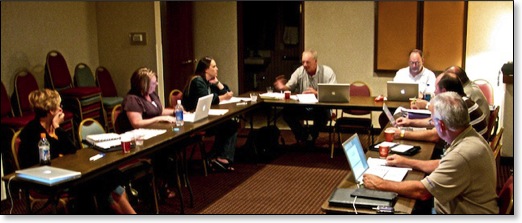
Why didn't we do the planning in Norfolk, NE, the home of Marathon Press? Simple: Rex Alewel, the owner of Marathon, also has a working tree farm in Concordia, so since the Kansas City workshop was close by, everyone came in to attend that event, then we did the planning in Concordia. That way we got to visit "The Ponderosa," our nickname for the Alewel farm, where we took in some welcome evening R&R, including guided tours of the farm with Rex at the wheel and passengers Patsy Hodge, Linda Varn, and Mark Weber . . .
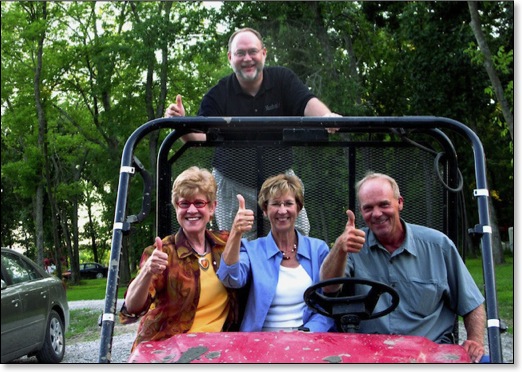
. . . and time to chill with the Alewel dogs Lucy and Lucky, shown below with Rob Merrill, Tina Joachim, Bruce Price, and Shannon Barry.

Moving on to Atlanta, I was delighted to teach the July 19 and 20 Studio Management Services Business Basics class with my pal Mary Fisk-Taylor. I am so intrigued with Mary's new Real Life Studios, a boutique studio in downtown Richmond that is the perfect counterpoint to Hayes & Fisk, the quintessential classical studio she operates with the incomparable Jamie Hayes. Here's Mary, shown below in green, hanging out with class members in front of PPA Headquarters.

Then on to Daytona for the 2008 International Print Judging, where PPA Print Exhibition Committee and Overall Jury Chair Helen Yancy delivered up marching orders to jurors, reminding us that "as the mother of 4 children and the grandmother of 12, I know how to keep you all under control." As well she did!

It was very entertaining watching PPA Board Member Susan Michal go the extra mile in creating the judges' official portrait.
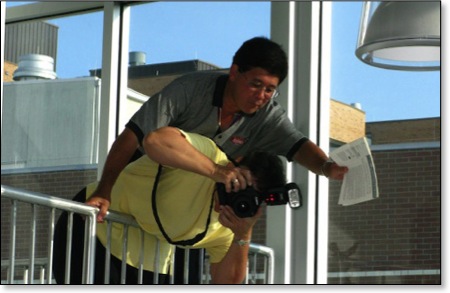
Later on, Helen and I had the pleasure of delivering to Susan a portrait of her darling Pomeranian that we jointly created. I took the photograph on a previous visit that Helen and I made to Susan's Florida home, then Helen finished the image using Corel Painter. If you would like to study Helen's artful painting style, you can do so at a workshop to be held at my Deep Creek home and studio on October 31 - November 3. To learn more about the class, click here.

Back on a plane to spend two days at home, change suitcases, then on to the next stop: Boston, and a wonderful group of New Englanders at the end-of-July Marathon Marketing Workshop. Unfortunately New England native Bill Camacho was sidelined because he was having shoulder surgery . . . the result of a soft-ball-game-gone-bad. We were happy to have John Miele on site to fill in for Bill.

The last leg of the trip took me back to Atlanta, where I joined Lori Nordstrom in teaching a 3-day SMS Workshop.
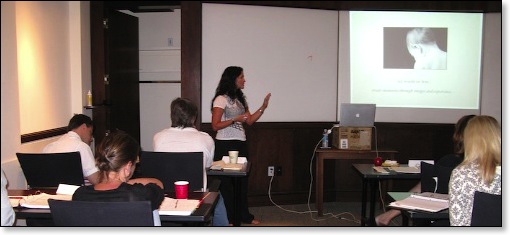
Because the PPA Board of Directors was finishing up its meeting in Atlanta, Lori and I were able to prevail upon Board Members and well-known instructors Carol Andrews and Ron Nichols to join our teaching team. In the image below, Ron provides a hands-on demo of the new ProSelect upgrade that puts even more sales tools in the hands of photographers.

After class, Carol, below left, and Board member Susan Michal join Lori and me for a "diva" photo. It was great spending time with these vibrant ladies!
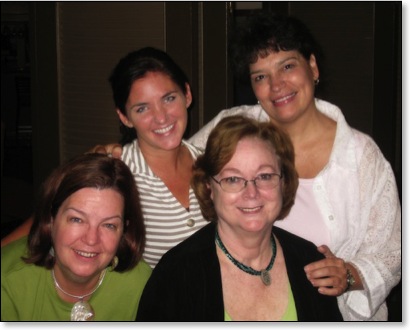
That wrapped up this year's longest road trip. What a month! Oh my, it is SO GOOD TO BE HOME!
Meanwhile, for the record . . . here's a quick summary of what I've been up to. You might see a few familiar faces:
Mark Weber, Bill Camacho and I worked with a great group of mid-westerners at the July 14-15 Marathon Marketing Workshop in Kansas City.

In nearby Concordia, MO, Bill, Mark and I joined with the Marathon executive team for two days of Marathon/Bellagrafica planning. Look at all those Macintoshes playing so nicely together! I think we look like a cult.

Why didn't we do the planning in Norfolk, NE, the home of Marathon Press? Simple: Rex Alewel, the owner of Marathon, also has a working tree farm in Concordia, so since the Kansas City workshop was close by, everyone came in to attend that event, then we did the planning in Concordia. That way we got to visit "The Ponderosa," our nickname for the Alewel farm, where we took in some welcome evening R&R, including guided tours of the farm with Rex at the wheel and passengers Patsy Hodge, Linda Varn, and Mark Weber . . .

. . . and time to chill with the Alewel dogs Lucy and Lucky, shown below with Rob Merrill, Tina Joachim, Bruce Price, and Shannon Barry.

Moving on to Atlanta, I was delighted to teach the July 19 and 20 Studio Management Services Business Basics class with my pal Mary Fisk-Taylor. I am so intrigued with Mary's new Real Life Studios, a boutique studio in downtown Richmond that is the perfect counterpoint to Hayes & Fisk, the quintessential classical studio she operates with the incomparable Jamie Hayes. Here's Mary, shown below in green, hanging out with class members in front of PPA Headquarters.

Then on to Daytona for the 2008 International Print Judging, where PPA Print Exhibition Committee and Overall Jury Chair Helen Yancy delivered up marching orders to jurors, reminding us that "as the mother of 4 children and the grandmother of 12, I know how to keep you all under control." As well she did!

It was very entertaining watching PPA Board Member Susan Michal go the extra mile in creating the judges' official portrait.

Later on, Helen and I had the pleasure of delivering to Susan a portrait of her darling Pomeranian that we jointly created. I took the photograph on a previous visit that Helen and I made to Susan's Florida home, then Helen finished the image using Corel Painter. If you would like to study Helen's artful painting style, you can do so at a workshop to be held at my Deep Creek home and studio on October 31 - November 3. To learn more about the class, click here.

Back on a plane to spend two days at home, change suitcases, then on to the next stop: Boston, and a wonderful group of New Englanders at the end-of-July Marathon Marketing Workshop. Unfortunately New England native Bill Camacho was sidelined because he was having shoulder surgery . . . the result of a soft-ball-game-gone-bad. We were happy to have John Miele on site to fill in for Bill.

The last leg of the trip took me back to Atlanta, where I joined Lori Nordstrom in teaching a 3-day SMS Workshop.

Because the PPA Board of Directors was finishing up its meeting in Atlanta, Lori and I were able to prevail upon Board Members and well-known instructors Carol Andrews and Ron Nichols to join our teaching team. In the image below, Ron provides a hands-on demo of the new ProSelect upgrade that puts even more sales tools in the hands of photographers.

After class, Carol, below left, and Board member Susan Michal join Lori and me for a "diva" photo. It was great spending time with these vibrant ladies!

That wrapped up this year's longest road trip. What a month! Oh my, it is SO GOOD TO BE HOME!